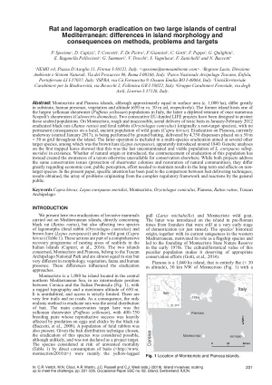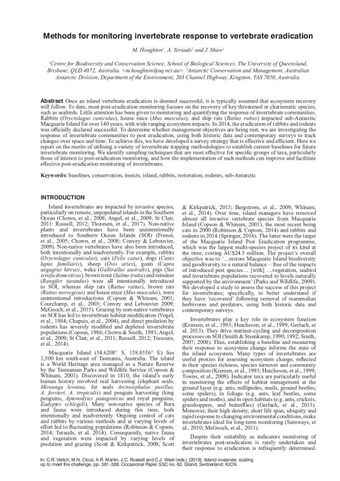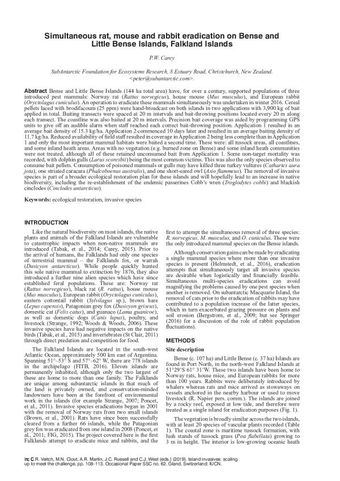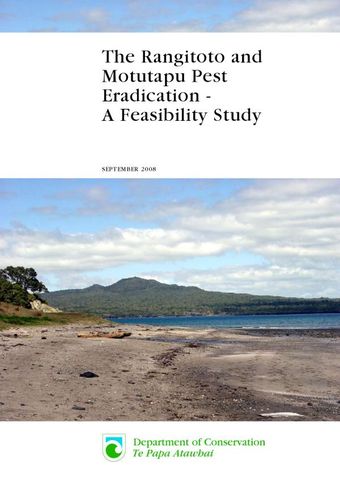Rat and lagomorph eradication on two large islands of central Mediterranean: differences in island morphology and consequences on methods, problems and targets
- Description:
- Montecristo and Pianosa islands, although approximately equal in surface area (c. 1,000 ha), di?er greatly in substrate, human presence, vegetation and altitude (650 m vs. 30 m asl, respectively). The former island hosts one of the largest yelkouan shearwater (Pu?nus yelkouan) populations in Italy, the latter a depleted remnant of once numerous Scopolis shearwaters (Calonectris diomedea). Two consecutive EU-funded LIFE projects have been designed to protect these seabird populations. On Montecristo, rough and inaccessible, aerial delivery of toxic baits in January-February 2012 eradicated black rats (Rattus rattus) and feral rabbits (Oryctolagus cuniculus) (originally a non-target species), with no permanent consequences on a local, ancient population of wild goats (Capra hircus). Eradication on Pianosa, currently underway (started January 2017), is being performed by ground baiting, delivered by 4,750 dispensers placed on a 50 m × 50 m grid throughout the island. The latter operation is included in a multi-species eradication aimed at several other target species, among which was the brown hare (Lepus europaeus), apparently introduced around 1840. Genetic analyses on the ?rst trapped hares showed that this was the last uncontaminated and viable population of L. europaeus subsp. meridiei in existence. Whether of natural origin or introduced, the commencement of eradication of this population has instead created the awareness of a taxon otherwise unavailable for conservation elsewhere. While both projects address the same conservation issues (protection of shearwater colonies and restoration of natural communities), they di?er greatly regarding economic cost, public perception, e? ort needed to maintain results in the long term and e?ects on non-target species. In the present paper, speci?c attention has been paid to the comparison between bait delivering techniques, results obtained, the array of problems originating from the complex regulatory framework and reactions by the general public.
- Display date:
- 2019
- Collections:
- Secretariat of the Pacific Regional Environment Programme (SPREP)
- Publisher:
- International Union for Nature Conservation (IUCN)
- Content partner:
- Secretariat of the Pacific Regional Environment Programme (SPREP)
- Availability:
- Not specified
-
Copyright status: All rights reservedFind out more about what you are able to do with this itemThis item is all rights reserved, with means you'll have to get permission from Secretariat of the Pacific Regional Environment Programme (SPREP) before using it. For more information, please see our use and reuse page.What can I do with this item?Non-infringing useNZ copyright law does not prevent every use of a copyright work, and this item may be hosted by an international institute or organisation. You should consider what you can and cannot do with a copyright work.No sharingYou may not copy and/or share this item with others without further permission. This includes posting it on your blog, using it in a presentation, or any other public use.No modifyingYou are not allowed to adapt or remix this item into any other works.No commercial useYou may not use this item commercially.
Related items
Welcome and warm Pasifik greetings
The information on this site has been gathered from our content partners.
The names, terms, and labels that we present on the site may contain images or voices of deceased persons and may also reflect the bias, norms, and perspective of the period of time in which they were created. We accept that these may not be appropriate today.
If you have any concerns or questions about an item, please contact us.



